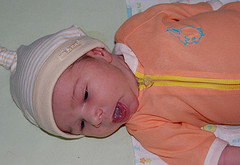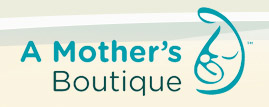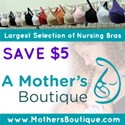
A baby with a white, yeasty tongue–she’s been diagnosed with thrush. Image Source
Right now, it seems like “supply” is all the rage when discussing breastfeeding challenges. This wasn’t always the case! A few years ago, thrush was the word of the hour. Of course, thrush is still alive and thriving among us, although my sources agree thrush is pretty rare. We’d like to give an overview of thrush, discuss some prevention tips, and review common treatments.
What is Thrush?
Thrush is a yeast infection–so, a fungus–caused by a little critter called Candida albicans. We all have this organism present, and usually our regular flora keeps it in check. It presents on the breast itself, but also transfers back and forth between mama and baby’s mouth.
Thrush presents in mama as burning nipple pain; itching, shiny, flaky skin on the nipples/areola; and deep or shooting pain in the breast. As we know, a number of different nursing challenges also present these same symptoms, so diagnosing thrush can be tricky. The text Counseling the Nursing Mother describes the pain of a Candida infection as, “feeling like hot cords burning in the chest wall”– intense, burning pain that radiates through the breast during or after feedings.
In babies, thrush appears like a white, filmy coating on the tongue (like milk tongue that doesn’t seem to go away). it can also present as a diaper rash, a pearly sheen inside the mouth, clicking during nursing, breast refusal, or excessive gas. (Many of these, too, can be symptoms of other problems! It’s all so confusing, which is why it’s so important to visit a medical provider for a diagnosis)
La Leche League International reminds us that moms and babies are at increased risk of developing thrush if either has recently taken antibiotics. History of vaginal yeast infection could make a mother more susceptible to thrush, too.
How Can We Avoid Thrush?
Taking care of the nipples can be a first line of defense. Yeast can sneak into cracked or wounded nipples, so if you sense this is coming, be sure to treat your nipples with care. Letting them air dry, applying coconut oil, or other ointments can work wonders in caring for nipples.
Oral contraception containing estrogen can make a mother more susceptible to thrush. Consider discussing alternate forms of contraception if thrush is a concern for you.
Take good care of nursing pads, nursing bras, and anything that comes in prolonged contact with your breasts. Damp materials that sit against milky nipples can invite thrush. Plastic lined nursing pads seem to prevent air flow to the nipple area more than cotton or cloth nursing pads.
If you or baby are prescribed an antibiotic, Kellymom says you can help prevent thrush by taking probtiotics. The article reminds us there is evidence in the medical literature that probiotics can decrease the risk of Candida overgrowth (Drisko 2003, Payne 2003, Kopp-Hoolihan 2001, Lykova 2000).
Probiotics can be found in yogurt or fermented foods (sauerkraut, kombucha, etc.), but are also found by themselves in chewable or liquid form. Take care to avoid sugary yogurts or probiotic drinks–sugar can help feed the yeast!
Breastfeeding is one way to avoid thrush–CTNM says infants who are predominantly breastfed have much less occurrence of Candida than babies who are fed with bottles (this could be linked to the challenges of properly sterilizing bottles and artificial nipples between feedings).
How Is Thrush Treated?
Take note: if a prescribed treatment for thrush does not work within a few days, chances are high you are actually dealing with another problem. MOST nipple pain is related to latch. So, a good first course of action is to really carefully evaluate baby’s latch, regardless of where you are in your nursing relationship.
Many providers say both the mother and nursling must be treated simultaneously, or else they will continue to pass the infection back and forth. Sometimes, just rinsing and air-drying the breasts in sunshine can help clear up mild thrush.
Yeast are tricky little organisms that can resist many forms of medication. Your care provider might suggest moving to a topical, over-the-counter antifungal ointment for mom. All Purpose Nipple Ointment is often a first prescription for mom that can help ease nipple pain while attacking the yeast organisms.
The International Breastfeeding Centre recommends diluted grapefruit seed extract application to the nipples in conjunction with APNO–the extract can also be added to laundry to help keep Candida at bay.
Infants are usually prescribed an oral antifungal, which parents apply with a cotton swab.
Gentian violet is available over the counter and has a long track record of success in treating thrush, though the International Breastfeeding Center suggests the Candida might be evolving to resist it. It’s an antiseptic dye with antibacterial/antifungal properties that you might have seen used on your baby’s umbilical cord stump! CTNM describes how this purple-colored ointment is swabbed on the mother’s breast as well as inside the baby’s mouth. The International Breastfeeding Centre cautions parents should look for 1% dilution, as this product can be very drying.
The next step would be an oral antifungal that the nursing mother would take. These are powerful medications, requiring prescription and monitoring by a physician.
Throughout the treatment process, it’s imperative that families exercise good hygiene: hand washing before and after diapering, using the toilet, and breastfeeding can help stop the spread of yeast. Boiling bras, breast shields, pump parts, etc. can also help to kill the Candida. CTNM suggests discarding anything that goes in the baby’s mouth, such as pacifiers, nipples, and teethers after one week of use. Plus, families should clean toys and clothing in hot water.
Have you and your baby experienced thrush? Leave us a comment to share your prevention and treatment tips!










